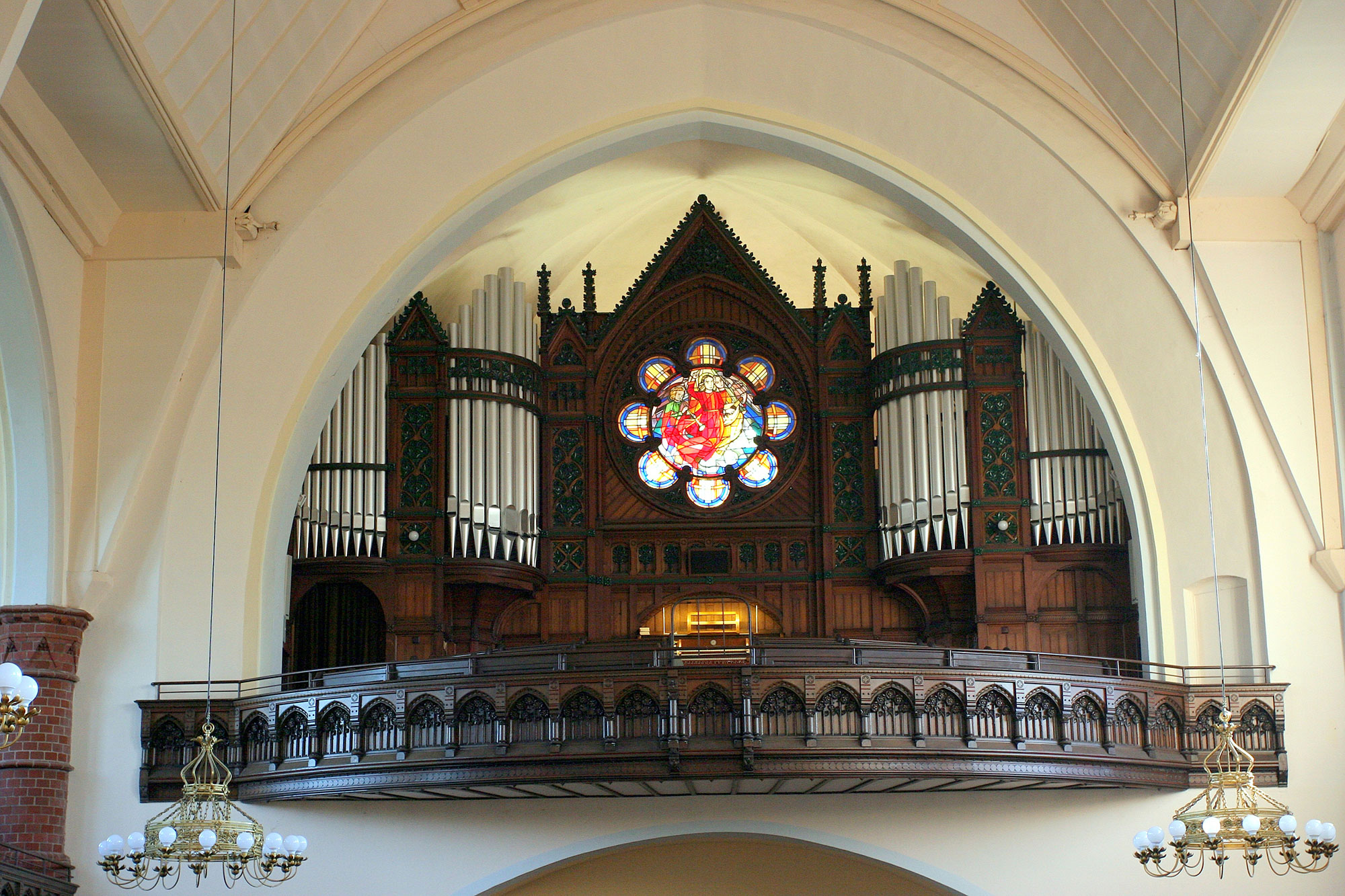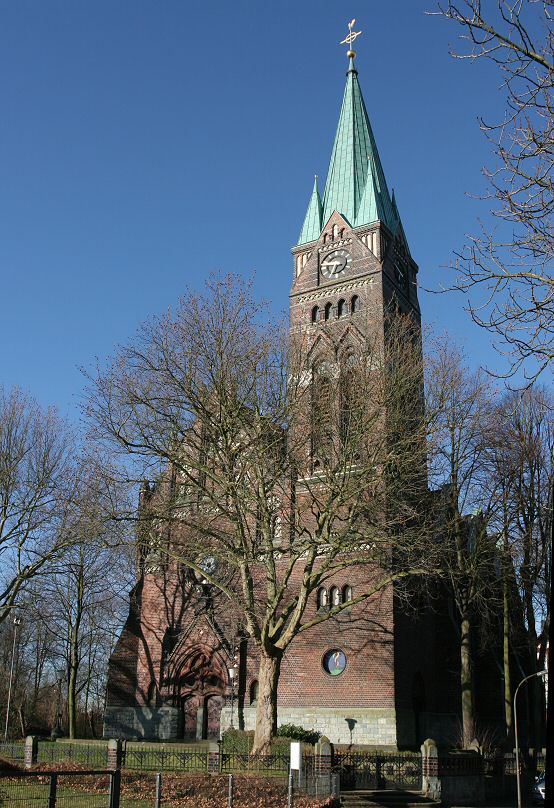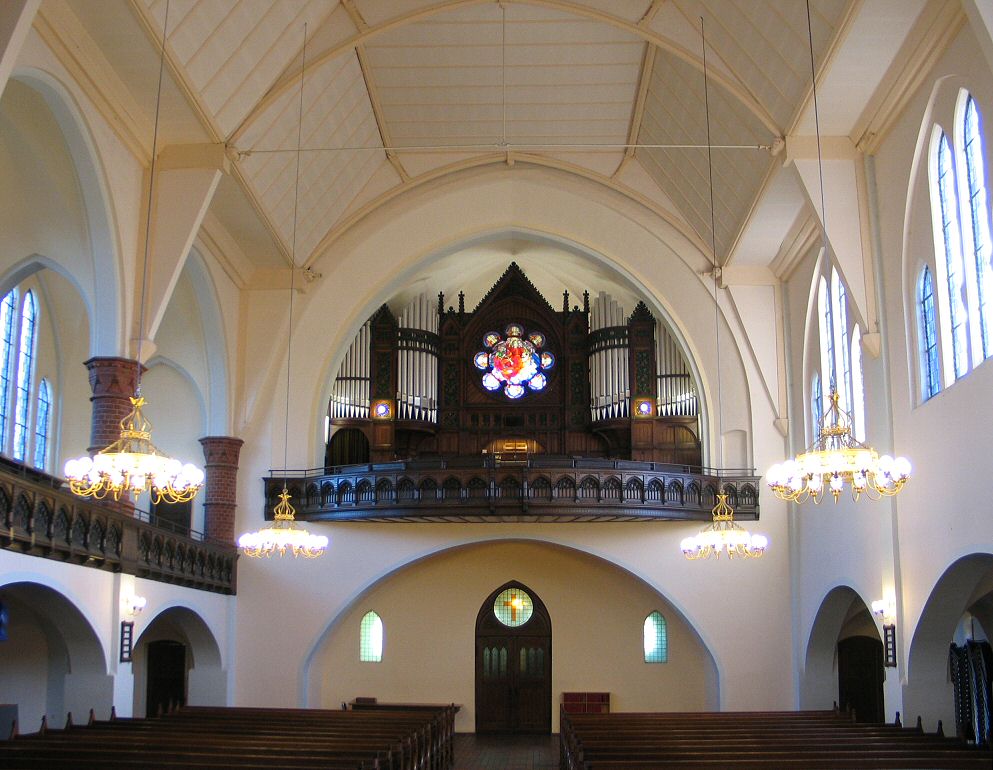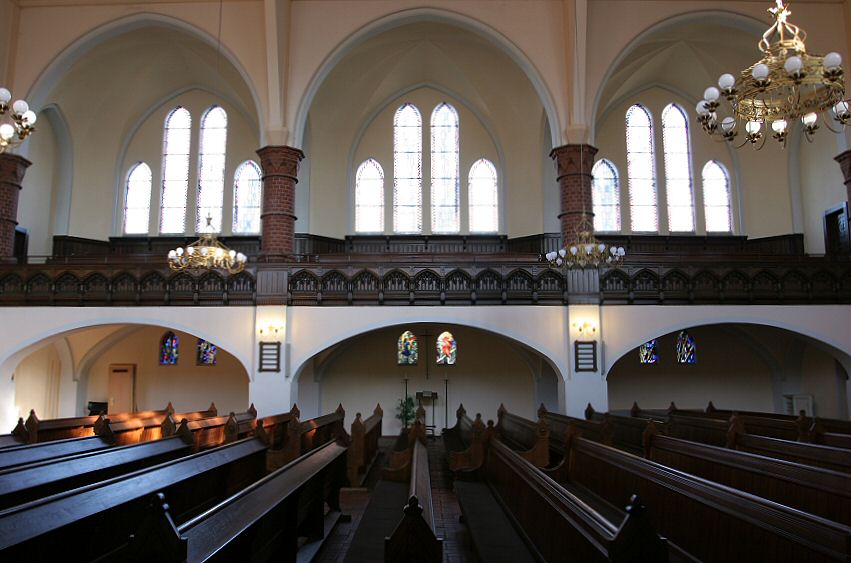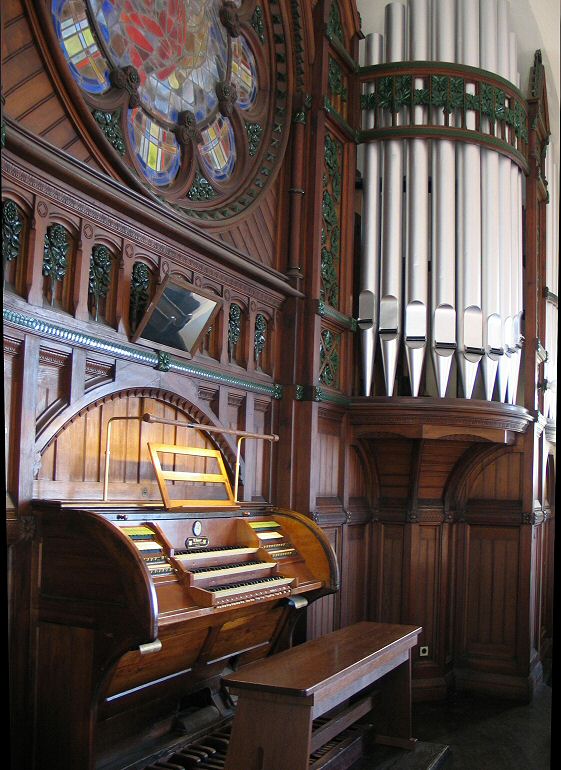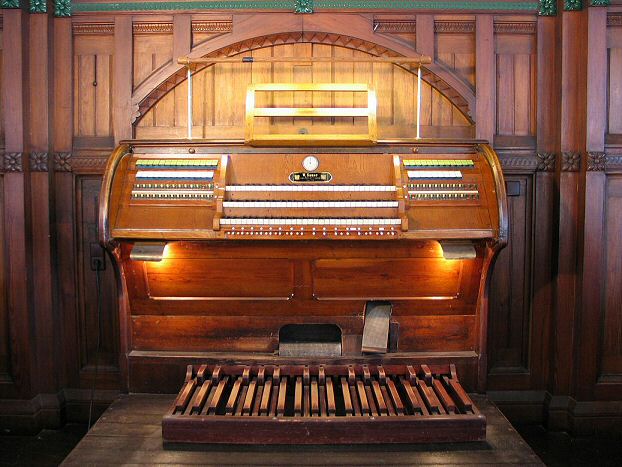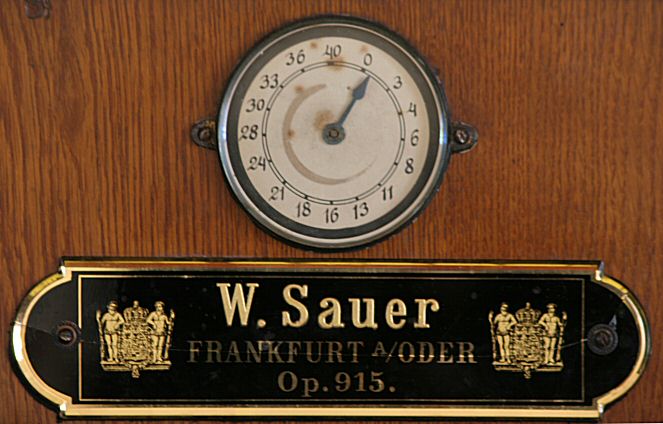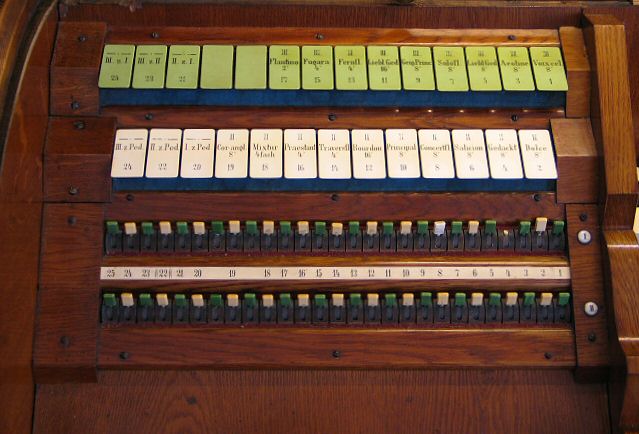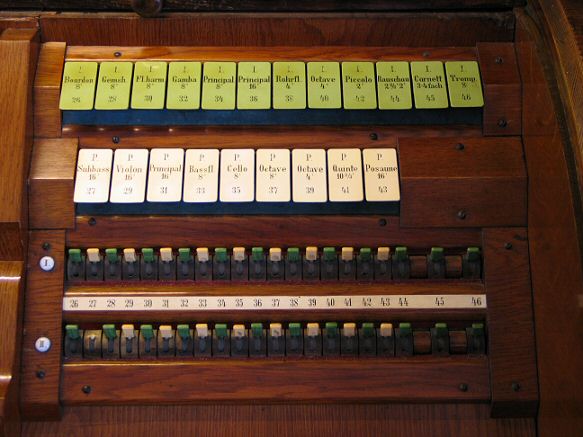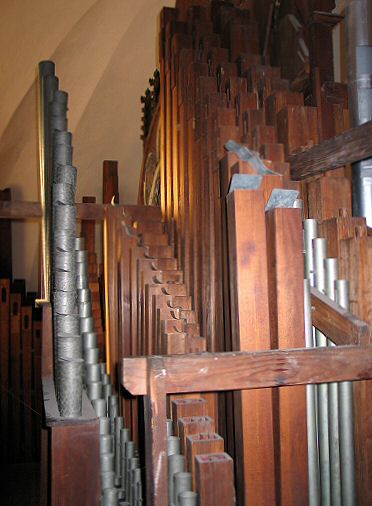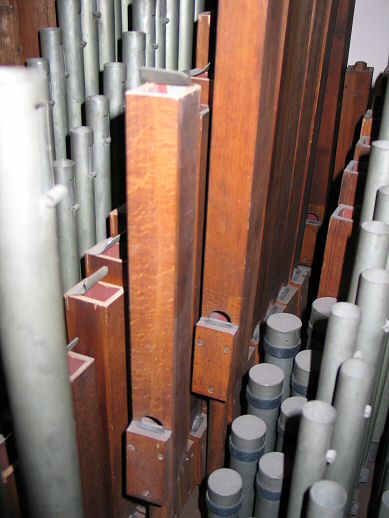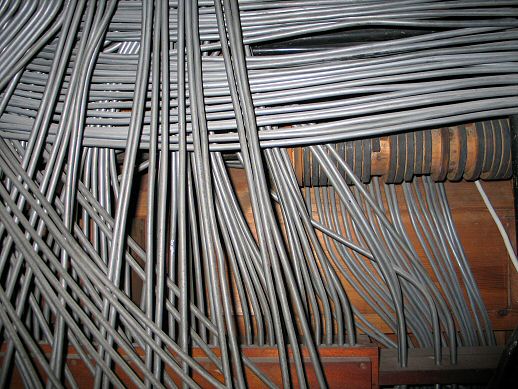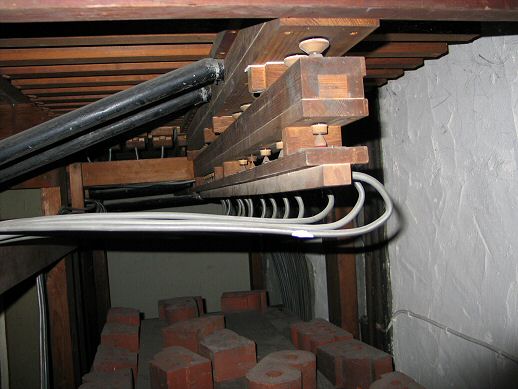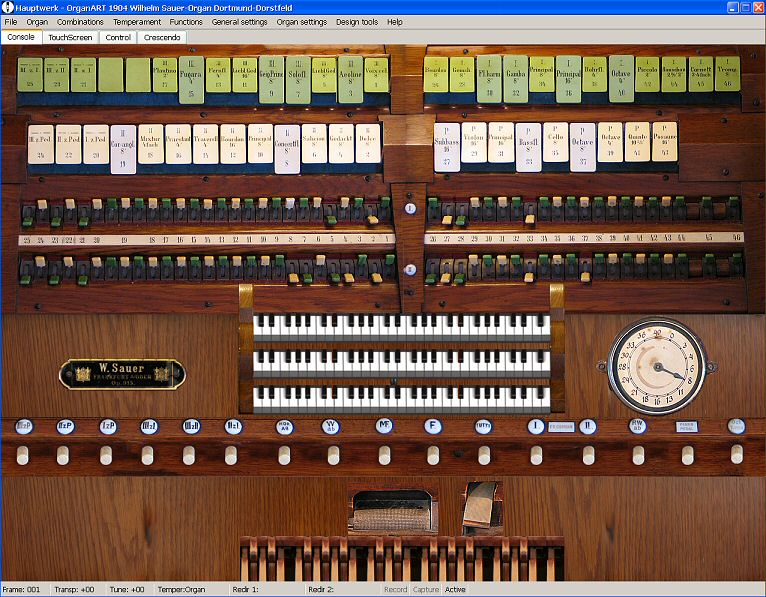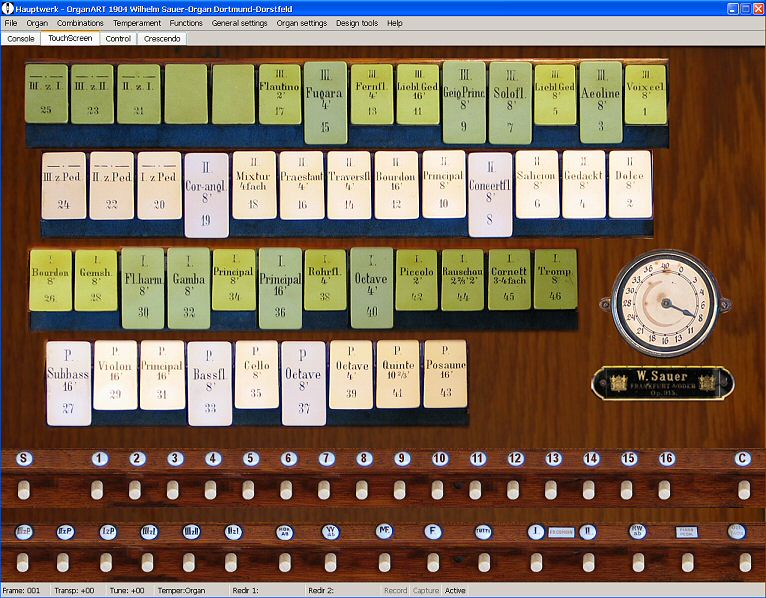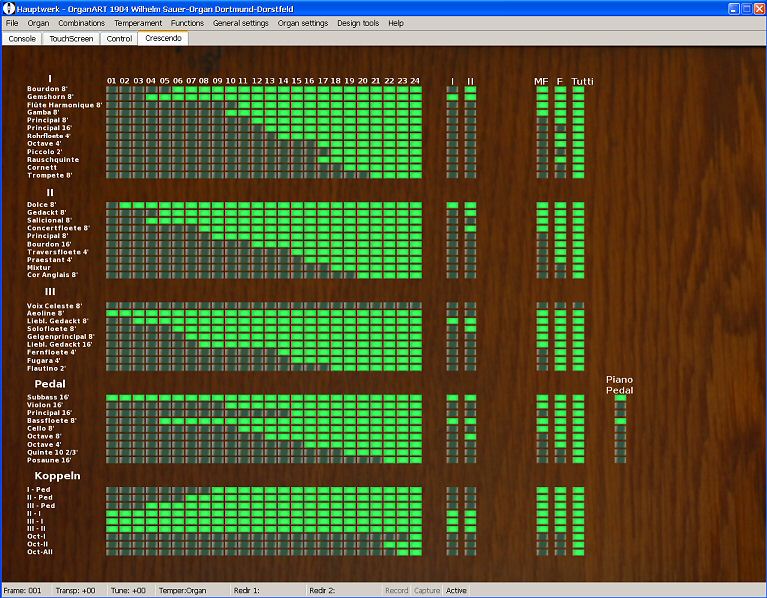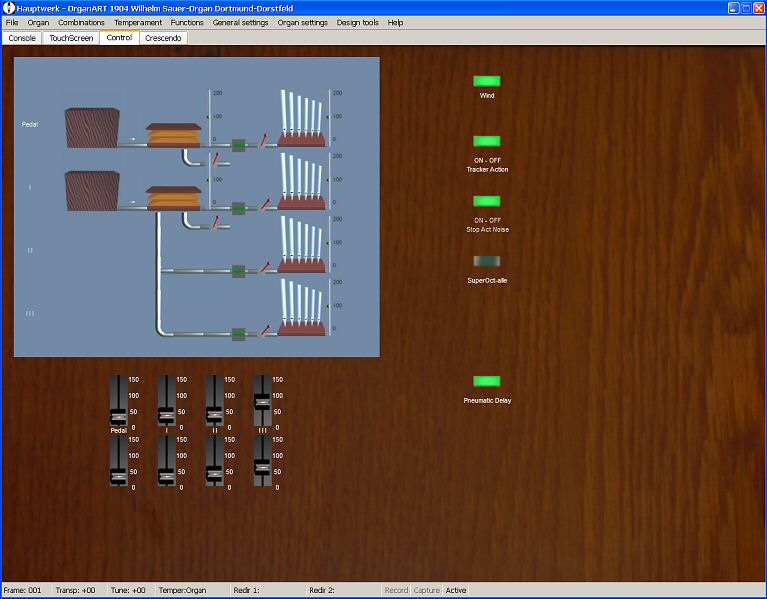1904 Wilhelm Sauer Late Romantic Organ op. 915
Dortmund/Nordrhein-Westfalen/Germany
Short Introduction and History
The 3-manual, 40-stop Wilhelm Sauer organ op. 915 of Dortmund-Dorstfeld in Northern Germany is located in a neo-Gothic brick church, built in 1904 for the strongly increasing population of the German "Ruhr-Gebiet", which was the largest area of coal mining in Germany.
The late romantic Sauer organ is one of the very few instruments in Germany, which have survived almost completely in their original state! This organ even survived four disasters, World War I and II, the German organ reform movement ("Orgelbewegung") and a church fire years ago, caused by a lightning strike, causing the burning tower to crash down into the church.
The front pipes (Principal 16) are actually made of zinc. It isn't possible to find out if they are the replacement of original tin pipes (tin front pipes usually had to be replaced during World War I, to support weapon production!) or if they were already used in the original organ. A lot of romantic organs used zinc front pipes before World War I, because the tin prices were very high at the time. There is no loss in tonal quality of this rank compared to the Principal 8 (tin), so that we could assume, that they are original.
Sauer (1831-1916) and Walcker were the most important and biggest organ manufacturers of that time and built more than a thousand instruments. Sauer himself was a volunteer at the Cavaillé-Coll (1811-1899) workshop for one year (about 1852), where the young Sauer met the organ building genius, whose fame grew more and more. Sauer very often is named as the "German Cavaillé-Coll". He transformed French organ concepts to the German sound concepts.
It is assumed that Sauer learned how to build high-quality overblowing pipes there, which we find in his instruments. Sauer's sound concept was based on the sound of the late-romantic symphonic orchestra and he tried to transform this sound into the organs.
The German romantic organ is like a paint-box, where you can add a lot of colours, thus getting new ones by additive mixing. Therefore you usually find a lot of 8ft stops. The registration is completely different from baroque organs. You always look for orchestral like tonal colours. The mixtures only crown the sound, but aren't leading voices. German reading customers may find an excellent article on sound concepts of German romantic organs with a lot of pipe sound examples by Gerhard Walcker-Mayer (see Links)
The (German) organ reform movement, which demanded a come-back of high-quality manufactured organs and considered the sound of Baroque organs as the only valid sound concept. This movement , not understanding (any more) the sound concept and music of romantic organs, usually resulted in a modification or even total dismantling of the (late-) romantic organs, especially in Germany. From today's point of view, we regret this consequence of the organ reform movement and usually don't find many of those organs in Germany.
When playing or listening to this organ, you will have the original sound of 1904 with a strong relation especially to the music of Max Reger. Reger himself and Sauer had good relations. Straube performed a lot of Reger works on the big Sauer organ of Leipzig.
The Dorstfeld organ has a wide range from very soft tonal colours (pppp) up to a very strong Tutti with some "brute force", which is necessary for Reger's work (ffff).
See Location in Googlemaps
Recording technique
The organ was recorded in February 2008 with 48 kHz, 24 bit, multi-channel for Hauptwerk 3, using the multi-release technique introduced by OrganART. The stops were recorded with multiple release levels for short, medium and long key attacks for optimal acoustical mapping.
Thanks
I would like to thank the parish of Dortmund-Dorstfeld for supporting this project.
Special thanks are due to Oliver Fiedler and Jörg Glebe for local assistance and organ workshop Christian Scheffler for a stand-by organ maintenance service and a lot of helpful information and discussions!
Last but not least special thanks to my wife, who assists all projects and is responsible for the photo documentation.
Virtual Console
Specification
NOTE: Click on the stop names for a small sound demo!
>
Manual I (C–g3)01. Principal 16' Manual II (C–g3)01. Bourdon 16' I zu Ped. |
Manual III (C–g3)01. Lieblich Gedackt 16' II zu I Pedal (C–f1)01. Principal 16' |
*) Overblowing pipes
Tracker action: Cone-valve chest with pneumatic tracker action
Couplers
II-I, III-I, III-II, I-P, II-P, III-P,
I-I 4' (Superoctave coupler)
Registration Aids
Programmable combinations: Two combinations
Fixed combinations: Pianopedal, Mezzoforte, Forte, Tutti
Reeds off
Main stops off
Roller Crescendo off
Roller Crescendo
Swell pedal Man. III
Requirements
Loaded Version |
Memory Requirements 3) |
Processor Speed |
|
16-bit, compressed1), single loop |
3600 MB |
≥ 2 GHz DualCore 2) |
|
16-bit, compressed, all loops |
4100 MB |
≥ 2 GHz DualCore 2) |
|
24-bit, compressed, single loop |
6500 MB |
≥ 2 GHz DualCore 2) |
| 24-bit, compressed, all loops |
7300 MB |
≥ 2 GHz DualCore 2) |
1) Lossless compression (no loss of sound quality!)
2) Recommended:
Minimal configuration:
Dual-Core, 4 GByte main memory, WIN-XP 64, Vista or MAC OS-X
Optimal configuration:
QuadCore, 8 GByte RAM, WIN-XP 64, Vista or MAC OS-X
3) To load this organ into Hauptwerk you will need enough free memory in your computer, due to the amount of playable stops, not including the operating system or any other programs that may be running!
The author is recommending the professional audio card RME HDSP 9632 (WIN XP/XP64) and uses the AKG Reference Headphone K701 for optimal sound and room impression.
Demos
The following demo pieces were recorded with the Hauptwerk Advanced Edition software and the Sauer organ set, with no additional effects processing.
Live recordings by Randall Mullin, USA
Sigfrid Karg-Elert (1877-1933):
Chorale-Improvisation: Jesu, geh voran, op. 65
Symphonic Chorale: Ach bleib mit deiner Gnade, op. 87
Live recordings by Anton Doornhein, NL :
Max Reger (1873-1916):
Benedictus op.59,9 4:16 min | Registration
Te Deum op.59,12 4:23 min Registration
Toccata d-moll und Fuge D-Dur op. 59, 5+6 (1901) | Registration
Toccata 3:40 min
Fuge 4:42 min
Romanze a-moll op.80,8
Man 1: Bourdon 8, Flûte Harm. 8, Gemshorn 8, II-I
Man 2: Concertflöte 8, Dolce 8, Gedackt 8, Salicional 8, III-II
Man 3: Aeoline 8, + - Liebl. Gedackt 8, Voix Celeste 8, III-I
Pedal : Subbaß16, Baßflöte 8. + - (Violon 16, II-P), + - (Principal 16, I-P), III-P
Franz Liszt (1811-1886)
Ave Maria 5:27 min | Registration
Adagio 3:16 min | Registration
C. Franck (1822-1890):
Pastorale 10:23 min | Registration
Prelude, Fuge et Variations 8:48 min | Registration
Johannes Brahms (1833-1897)
Choralbearbeitungen op. 122
No. 10 "Herzlich tut mich verlangen"
Man 1: Bourdon 8, Gemshorn 8, III-I
Man 2: Concertflöte 8, Gedackt 8, Cor Anglais 8
Man 3: Geigenprincipal 8, Liebl. Gedackt 8, Soloflöte 8
Pedal : II-P
No. 5"Schmücke Dich o liebe Seele"
Man 1: Bourdon 8, Rohrflöte8
No. 9 "Herzlich tut mich verlangen"
Man 1: Principal 8, Bourdon 8, Flûte Harm. 8, Gemshorn 8, II-I
Man 2: Concertflöte 8, Gedackt 8, III-II
Man 3: Geigenprincipal 8, Liebl. Gedackt 8, Soloflöte 8
Pedal : Principal 16, Subbaß 16, Baßflöte 8, I- P, II-P, III-P
F. Mendelssohn-Bartholdy (1809-1847)
Sonate No.2 c-moll op.65, 2
1st Mvmt: Grave, Adagio 4:34 min
Man 1: Principal 8, Bourdon 8, Gemshorn 8, II-I, III-I (Adagio: not used)
Man 2: Principal 8, Gedackt 8, III-II
(Adagio: Gedackt 8, Concertflöte 8, Cor Anglais 8)
Man 3: Geigenprincipal 8, Liebl. Gedackt 8, Aeoline 8, Fugara 4, Fernflöte 4
(Adagio: Liebl. Gedackt 8, Aeoline 8, Fernflöte 4 )
Pedal : Principal 16, Violon16, Subbaß 16, Octave 8, Baßflöte 8, I-P, II-P, III-P
(Adagio: Subbaß 16, Baßflöte 8, III-P)
2nd Mvmt: Allegro maestoso e vivace 2:11 min
Man 1: Principal 8, Bourdon 8, Gemshorn 8, Octave 4, Rohrflöte 4, Piccolo 2,
Rauschquinte 2f, Cornett, Trompete 8, II-I, III-I
Man 2: Bourdon 16, Principal 8, Gedackt 8, Praestant 4, Traversflöte 4
Mixtur 4f, Cor Anglais 8, III-II
Man 3: Geigenprincipal 8, Liebl. Gedackt 8, Aeoline 8, Fugara 4, Fernflöte 4
Pedal : Tutti, - + Posaune 16, I- P, II-P, III-P
3rd Mvmt: Fuge 3:33 min
Man 1: Principal 8, Bourdon 8, Gemshorn 8, Octave 4, Rohrflöte 4, Piccolo 2,
Rauschquinte 2f, + Trompete 8, +(Principal 16, Super-I, Super-All), + Cornett, II-I, III-I
Man 2: Principal 8, Gedackt 8, Praestant 4, Traversflöte 4, Mixtur 4f,
+ Cor Anglais 8, + Bourdon 16. III-II
Man 3: Geigenprincipal 8, Liebl. Gedackt 8, Aeoline 8, Fugara 4, Fernflöte 4, + Liebl. Gedackt 16
Pedal : Principal 16, Violon16, Subbaß 16, Octave 8, Baßflöte 8, Cello 8, Octave 4, I-P, II-P, III-P
´
Live recordings by Andreas Mattes, Germany
Josef Gabriel von Rheinberger (1839-1901):
Sonate No.4, a-moll, (Tonus peregrinus) op. 98
1- Tempo moderato
2- Intermezzo
3- Fuga chromatica
______________________________________________________________________
MIDI-Demos:
Max Reger (1873-1916):
Phantasie und Fuge d-moll op. 135b (Late version):
Phantasie 4) 5:50 min
Fuge 4) 8:16
Melodia op. 129,4 3)
Man 1: Gemshorn 8
Man 3: Geigenprincipal 8, Fernflöte 4, Voix Celeste
Pedal : Subbaß 16, I-P
Capriccio (Intro) op. 129,5 3)
Man 1: Bourdon 8, Octave 4
Man 3: Liebl. Gedackt 8, Fernflöte 4, Fugara 4
Pedal : Subbaß 16, Octave 8
Christus, der ist mein Leben, op. 67, 5 2)
Man 1: Bourdon 8, Octave 4, Rohrflöte 4, Rauschquinte, Piccolo 2, II-I
Man 2: Bourdon 16, Principal 8, Gedackt 8, Praestant 4, Traversflöte 4, Mixtur
Pedal : Principal 16, Subbaß 16, Octave 8, Cello 8
Dir, Dir, Jehova will ich singen, op. 67, 7 2)
Man 1: Bourdon 8, Flûte Harm. 8, Principal 8, Gamba 8, Gemshorn 8, Octave 4, Rohrflöte 4, Rauschquinte,
II-I, III-I, Superoctave
Man 2: Principal 8, Gedackt 8, Dolce 8, Salicional 8, Concertflöte 8, Praestant 4, Traversflöte 4, Mixtur
Man 3: Liebl. Gedackt 16, Liebl. Gedackt 8, Soloflöte 8, Geigenprincipal 8, Aeoline 8, Fugara 4,
Fernflöte 4, Fugara 4
Pedal : Principal 16, Subbaß 16, Violon 16, Octave 8, Baßflöte 8, Cello 8, Octave 4, I-P, II-P, III-P
Kleine Choralvorspiele op. 135
No. 1: Ach, bleib mit Deiner Gnade 2)
Man 2: Traversflöte 4 (8va bassa)
Man 3: Liebl. Gedackt 8, Soloflöte 8 (Swell nearly closed)
Pedal : Subbaß 16
No. 17: Meinen Jesum lass ich nicht 2)
Man 1: Gemshorn 8, Gamba 8, Rohrflöte 4
Man 2: Gedackt 8, Salicional 8
Pedal : Subbaß 16, Baßflöte 8
No. 9: Freue dich sehr, o meine Seele 2)
Man 1: Bourdon 8, Gamba 8, Gemshorn 8, Rohrflöte 4, Trompete 8, + Cornett
Man 2: Dolce 8, Salicional 8, Cor Anglais 8, Traversflöte 4
Pedal : Principal 16, Subbaß 16, Violon 16, Octave 8, Baßflöte 8, Cello 8, II-P
Louis Vierne (1870-1937):
Idyll Melancolique op. 31,8 2)
Man 1: Flûte Harm. 8, Gemshorn 8, II-I
Man 2: Concertflöte 8, Dolce 8, Salicional 8, III- II
Man 3: Liebl. Gedackt 8
Pedal : Subbaß 16, I-P
Madrigal op. 31,9 2)
Man 1: Bourdon 8, Gemshorn 8, II-I
Man 2: Dolce 8, Traversflöte 4
Man 3: Aeoline 8, Geigenprincipal 8, +- Fugara 4
Pedal : Subbaß 16, I-P
J. S. Bach (1685-1750):
Sinfonia Cantata BWV106a 2
Man 1: Flûte Harm. 8, III-I
Man 2: (Dolce 8, Salicional 8) 8va
Man 3: Soloflöte 8
Pedal : Subbaß 16, II-P
Choral "Herr Christ der ein'zge Gottes Sohn" BWV 601 2)
Man 1: Principal 8, Octave 4, Rohrflöte 4, Piccolo 2, Cornett, Rauschquinte , Trompete 8
Man 2: Cor Anglais 8, Mixtur
Pedal : Principal 16, Octave 8, Baßflöte 8, Octave 4, I-P, II-P
Sources:
Live recordings:
Randall Mullin, USA
Anton Doornhein, NL
Andreas Mattes, Germany
1) MIDI file Borsari, mod. OAM
2) MIDI file J. Pressler Virtually Baroque/mod. OAM
3) MIDI file, mod. OAM, unknown author
4) MIDI file OAM
5) MIDI file Ikenoue, mod. OAM
6) MIDI file van Zetten, mod. OAM
© OrganART Media, all rights reserved
No demo sounds may be used or transmitted in any form for public purposes without the prior permission of the publisher!
Informations and Weblinks
Sebastian Küchler-Blessing plays Max Reger op. 52,3 at the Hauptwerk console of Jörg Glebe, Germany
Sebastian Küchler-Blessing plays Max Reger op. 52,3 at the Hauptwerk console of Jörg Glebe, Germany


